


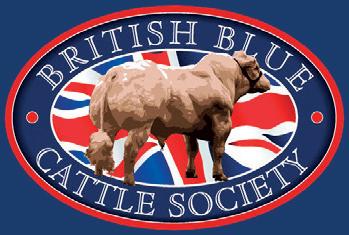


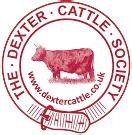
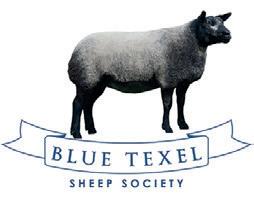
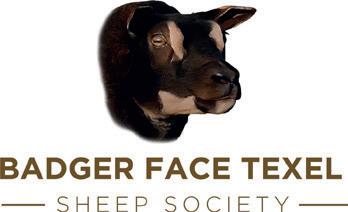
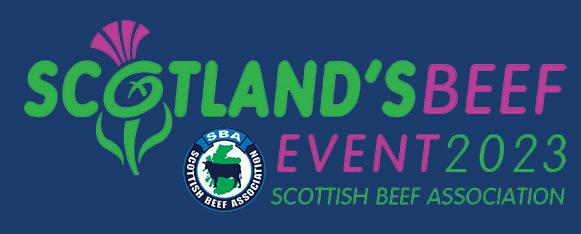



Call 01772 799500 and place your ad today 51 May 26, 2023 | FGbuyandsell.com This special feature includes features on pedigree beef and sheep breeds, as well as society news. BREED SOCIETIES SPECIAL Edited by Angela Calvert angela.calvert@agriconnect.com 07768 796 492 All of these societies are managed by Pedigree Livestock Services, please contact Andy Ryder on 01768 870522 for further information 61 LINCOLN REDS Producing what the customer wants 64 INCREASED POPULARITY North Country Cheviots in Ireland 66 NEXT GENERATION The role of breed societies 52 BRITISH WHITES A rare breed being run commercially 55 CONSERVATION GRAZING Wiltshire Horn sheep prove their worth 58 PROFITABILITY Brown Swiss add value to dairy herd
The Emily Estate is a diverse rural estate covering 890 hectares (2,200 acres) and including the Newt in Somerset, which is a hotel and garden attraction. At the estate’s heart, there are 486 hectares (1,200 acres) dedicated to the world’s largest herd of British White cattle.
The estate is owned and currently being redeveloped by South African businessman Koos Bekker and his wife Karen Roos.
It employs more than 500 people, of which over 75 per cent live within 15 miles. Last year, they welcomed more than 200,000 visitors, making a major contribution to the local and regional economy. The whole estate is now farmed in hand, apart from one dairy farm.

The British White was chosen for the estate due to its history, as this breed was often an estate animal; spotted in parks and setting the scene around grand homes.
The day-to-day running of the farm is managed by experienced herdsman Cameron Knee, who joined the team last autumn
British Whites at the centre of Somerset estate’s enterprise
following a career as an agronomist and working with pedigree Charolais cattle. The herd was established when the estate was bought by Mr Bekker five years ago, and since then has grown to 330-head.
Mr Knee says: “These cattle may be a rare breed, but here they are farmed in a commercial manner.
The British Pig Association looks after 10 native breeds from Berkshires to Welsh. Each one is unique and all of them are at risk.




If you want great tasting pork and you also want to be part of a fantastic breed conservation programme, then pedigree pigs are the way to go.
We have three restaurants and a farm shop which demand two carcases a week, so the cattle have to be finished on time to support the other business ventures.”
But despite being run commercially, Mr Knee is passionate about keeping the breed true to type, especially when it comes to their markings.
“British Whites can be over or under marked, but we are trying to phase this out of the herd. We aim to run a high quality herd, so this is of upmost importance to us,” he says.
Rare
The herd also includes five rare red-marked British White cows. The red-marked cattle look identical to the black-marked cows but have dark red pointing instead of the black pointing; similar to a British Shorthorn.
“These are really rare, and I
never see these for sale. They are often bigger than the white cows and they are really pretty.
“We have just bred our first red-marked bull, so we are really excited to see what this could lead to,” says Mr Knee.
The herd was sourced from farms across the country. However, many of the cows were older, so effort is going into breeding correct, feminine and milky heifers which are easy fleshing. The calving is split, with 60 per cent in spring and the remainder in autumn.
“The British White are not the milkiest of cows, but are good calvers considering they are prone to having a narrow pelvis,” says Mr Knee.
Some of his efforts are therefore driven to increase the motherly traits of the cow. This year, they are keeping 30 heifers and are being more selective about their replacements. Over the past two years they
BREED SOCIETIES FGBuyandSell.com FGbuyandsell.com | May 26, 2023 52
Visit our website www.britishpigs.org or follow us on FaceBook @britishpigs #bpadoyourbit #eatthemtosavethem
A Georgian stately home on a Somerset estate is a fitting backdrop for a traditional cattle breed such as the British White. Ellie Layton finds out more.
Herdsman Cameron Knee (left) and John McWilliam.
have kept more than 80 home-bred heifers to make the herd more youthful, and several heifers were bought this year from the society sale at Melton Mowbray.


Mr Knee says: “We want to support society sales and other breeders as the future of securing the





rare breed can be improved by working together.”

The British Whites are also being taken on a different breeding path.
The owner of the estate breeds Chianina cattle, which originate from Tuscany, Italy. Chianina cattle are




much larger than traditional breeds and are very leggy, so the two breeds are being crossed to see what they will produce. They tried to import genetics during Covid-19, however it proved difficult.

But they finally managed to
import semen and have just seen the first calves on the ground.
“These are much larger than traditional British White calves, although they are marked very similar. We hope that these will come in useful for the butchery as

BREED SOCIETIES Call 01772 799500 and place your ad today FGbuyandsell.com 53 May 26, 2023 | Red Ruby Devons The Supreme Grass-to-Beef Machine www.redrubydevon.co.uk email: dcbs@redrubydevon.co.uk | Tel: 01404 47863 with thanks to our Donations from: Colleton Herd, Coxwell Herd Durwood Herd,
Herd, Priorton Herd Pusey Farms Herd, Trenowin Herd For For Beef: National Show 2017 The Supreme Grass-to-Beef Red Ruby Devons Devo y n ub Ca R t d tl e e R R e e l d tt R a u C b n y voDe
Overtown
We want to support society sales and other breeders as the future of securing the rare breed can be improved by working together CAMERON KNEE
The herd is completely grass-fed and is given chopped straw and silage when housed.
Emily Estate is home to the world’s largest herd of British White cattle.
PICTURES: NIGEL GOLDSMITH
SOCIETIES
a traditional Chianina carcase is nearly twice the size of the current carcase for the shop,” says Mr Knee.
The cows are suited to the traditional varied styles of grasses which the estate offers, but Mr Knee says that they are not to be rushed when finishing.
“We have been able to finish the cattle as early as 16 months. However, the cattle are taken to a local abattoir 20 miles down the road, and the fat and muscle development is not mature enough. Therefore, we aim for a 24- to 26-month finished age to ensure that the meat is of the highest quality for the customers,” he says.
The herd is completely grass-fed and is given chopped straw and silage when housed.

Mr Knee adds: “It can be difficult to keep condition off the cows before bulling and before they calve, so we find this strict diet
can help keep the weight off.
“Due to the narrower pelvic width on the cattle, we focus on keeping the calf size down.”
For the first time, the estate has planted oilseed rape. There are plans to extract the oil for the farm shop and then use the rape straw for feeding during winter months. The estate is trying to lessen its carbon footprint, so introducing rape will reduce feed purchased for the farm.
Round house
A round house was built in 2019, which is used to house the cattle while they are being fattened. It is split into pens and each group is rotated round the pens as they fatten. The cattle are weighed weekly from birth until they are sent to the abattoir.

“We want to get as much data from the herd as possible so that we can enhance our breeding,” says Mr Knee.
The round house is very useful to
The Traditional No Shearing Sheep
show estate visitors the cattle and has proved so successful that the building of three more is in progress.
Looking to the future, Mr Knee wants to apply his pedigree knowledge to showing stock and selling bulls from the herd, and he is entering the herd into a health scheme to make this possible.
Alongside the herd, the estate runs a flock of Hampshire Down
Farm facts
■ Pedigree herd of 330 British White cattle
■ Estate includes hotels, restaurants and a farm shop

■ Largest herd of British White cattle in the world
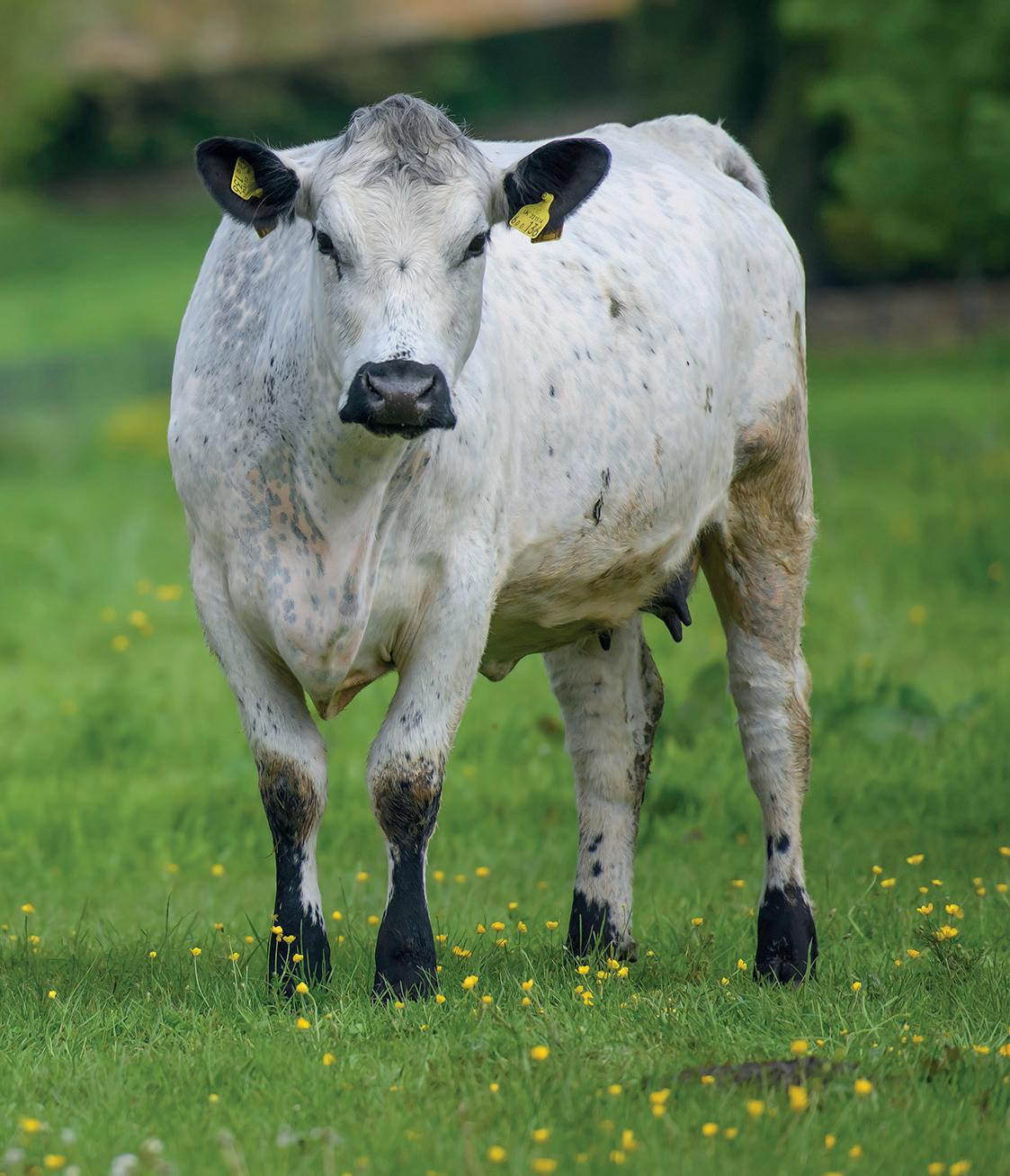
■ Both the sheep and cattle enterprises are being expanded
cross Blue Du Maine ewes. These are being doubled over the next year to meet shop demands, and recently one of the farm’s estates was taken back in hand to support them.
BREED
FGBuyandSell.com FGbuyandsell.com | May 26, 2023 54
P r e m i e r S h o w & S a l e 1 6 t h S e p t Stoneleigh CV8 2RG Tel: 02476 697 731 North Wales Show & Sale 11th Sept Gaerwen LL60 6DF Tel: 01248 421 582 C e n t e n a r y S h o w & S a l e s 2 0 2 3 01925 754932 info@wiltshirehorn.org.uk www.wiltshirehorn.org.uk Catalogues available September: online, from markets or from WHSS
The roundhouse is very useful for showing the cattle to visitors.
British Whites were chosen for the estate due to their history.
Founded in 1959 by volunteers, Essex Wildlife Trust protects and manages more than 100 sites across Essex and is supported by 40,000 members.
Together, they work together to protect the future of wildlife and nature in Essex.
Many of the trust’s nature reserves require sensitive, well-timed conservation grazing. Habitats in the county where grazing is a key part of sympathetic management include coastal grazing marsh, wet grassland, acid grassland, heathland, freshwater wetlands, scrub pasture and water meadows.
The trust’s acting grazing officer Harry Smith says: “We use our grazing animals, sheep and cattle to graze many of our nature reserves around the county to manage habitats for the benefit of wildlife .

of grazing Wiltshire Horn sheep
“We keep native breeds, such as Wiltshire Horn sheep and Red Poll cattle, as they are better adapted to our climate, terrain and the demands of conservation grazing.
“As our sites are nature reserves, they are not managed for food production like conventional farmland and, therefore, we do not have the same
pressures of a commercial business, such as selling or finishing animals.
“The aim with our grazing animals is to promote wildlife species of conservation concern and maximise biodiversity on our grazed sites.
Marshland
“Sheep are particularly useful on marshland as they will graze the grass short, an ideal length for wintering geese to graze. We have reserves, such as our larger grassland sites, where there is an overlap with the agricultural calendar and activities such as haymaking and seasonal grazing take place.”


The trust’s sheep flock consists of Wiltshire Horn, Black Welsh Mountain and Herdwick crosses.
The two hill breeds lend themselves to the year-round outdoor system and to the grazing conditions which can sometimes be very poor.
The trust ventured into Wiltshire Horns in 2022 after Mr Smith had run his own flock of Wiltshires for a year and saw an opportunity to reduce the inputs, time and labour for the trust with the breed.
The self-shedding trait was a selling point to reduce labour and Mr Smith had some prior experience of this with primitive Soay sheep, but wanted a
BREED SOCIETIES Call 01772 799500 and place your ad today FGbuyandsell.com 55 May 26, 2023 | Hampshire Down Sired Lambs The First to Finish FIRST FOR GROWTH & FINISH* EXCEPTIONAL FEED CONVERSION THE EFFICIENT & SUSTAINABLE CHOICE Join the winning team. You can’t afford not to. www.hampshiredown.org.uk @hampshiredownsheepassociation @HampsSheep @HampsSheep The Quality Hill Breed VERSATILE | HARDY | PROFITABLE www.nc-cheviot.co.uk Corinna Cowin | 07834 817 710 | secretary@nc-cheviot.co.uk NORTH COUNTRY CHEVIOT SHEEP SOCIETY #NothingCanCompare
Benefits
Wiltshire Horn sheep have key characteristics needed for conservation grazing, as the Essex Wildlife Trust has found out.
Harry Smith
PICTURES: MARTIN APPS
breed which was easier to manage and move between sites as some of the primitive native breeds, although very hardy, can be flighty.
The trust bought a small nucleus flock of 60 pedigree Wiltshire Horn ewes, most of which were from Signet recorded flocks and a Wiltshire Horn ram which had an estimated breeding value index in the top 5 per cent for the breed.
Mr Smith says: “ The characteristics we were interested in were those which would promote welfare and reduce labour and inputs for the flock.
“The key traits we want to champion are ease of lambing, maternal ability, good feet and importantly a fleece which sheds early in the season and grows in a tight manner.

“Early fleece shedding in April and a tight fleece, apart from the obvious, which is we do not have to shear them, is also an attempt to reduce the amount of chemical pour-ons used as the impact of some of these chemicals on wider insect populations on our sites is unknown, but likely to be detrimental, plus they are costly.
Fly strike

“That said, it is not just fly strike that these chemicals help manage. We have an increasing tick burden on many of our coastal sites around the county which we also need to monitor and manage if necessary.
“A tight, less woolly fleece is also













Wiltshire Horn sheep
THE Wiltshire Horn is the original no-shearing sheep. It has a short fleece which naturally sheds in spring leaving a short hair coat.
The fleece will then grow again in autumn for protection in winter.
One of the oldest native lowland breeds, the Wiltshire Horn is low maintenance with low-input costs and is suited to both indoor and outdoor systems, producing lambs which finish off grass, and it crosses well with other breeds.
The Wiltshire Horn Sheep Society is celebrating its centenary this year, having been established in January 1923 when 40 farmers and breeders met in Northampton to put the breed on ‘sound pedigree lines’, after its popularity declined
desirable for conservation grazing where we have sites with scrub and bramble. Other breeds with a heavy longer fleece can easily become caught and trapped in this sort of vegetation, whereas we have had fewer issues with the Wiltshires.”
In 2023, the flock lambed from April to mid-May at Blue House Farm Nature Reserve , which is a low-lying coastal grazing marsh in south east Essex.
Mr Smith lives on-site in the trust’s farmhouse, so it made sense to lamb the flock on-site.
in the 19th century when the economy became reliant on wool.
The breed prospered until the early 1960s, but then declined due to the soaring value of the pelts of other breeds.
In the 1970s, the breed came under the protection of the Rare Breeds Survival Trust because numbers were so low.
But in recent years, the number of registered sheep has significantly increased and the breed has moved forward as sheep quality has improved and more producers appreciate its self-shedding benefits.

On the importance of the breed society, its secretary Paul McAvoy says: “Preserving the unique genes of the Wiltshire Horn sheep ensures

Mr Smith says: “We lambed outside and once satisfied that the ewe and lambs had mothered up, we walked them into hurdles at the side of the field to tag, castrate and number the lambs, then move with an ATV and trailer to a new field.
“We had a fairly kind spring down south, with only a couple of wet days, but it was still fairly warm, so losses were minimal.
“The Essex grazing marshes are very exposed places and wind chill and waterlogged ground are big factors to
they are not diluted, genes continue to exist and excellence can be traced and potentially replicated.
“Their ability to shed fleece annually has been much sought after of late and has contributed to the development of Easycare and Exlana sheep.
“However, it is essential the original pure Wiltshire Horn DNA must be maintained so future opportunities for breeding and development will not be lost.”
A number of events are planned for the society’s centenary year, along with the national show at Royal Three Counties Show.
MORE INFORMATION
wiltshirehorn.org.uk
consider for lambing outside. The Wiltshires do benefit from a bit of shelter, such as undulating ground and hedgerows to get out of the wind, but with a bit of forward planning, fields with these features can be set aside for lambing.”
According to Mr Smith there are two key considerations for conservation grazing.
Firstly, to get stocking density right, which means grazing with the right number of animals, which is typically a lot lower than conventional stocking density and this varies depending on the habitats being managed and what needs to be achieved.

On a site managed for ground nesting birds, any grazing needs to be at a very low stocking density of less than 0.75 livestock units/hectare (0.3 livestock units/acre) during the ground nesting bird season from March to July.
The second key consideration is seasonal timing. The arrival of grazing animals at the optimal time is important to promote key species and habitats.
On many of the sites, grazing animals are only introduced after most wildflowers have set seed or on aftermath grazing from a hay cut from July onwards.
But some of the larger grassland sites require light spring grazing to



BREED SOCIETIES FGBuyandSell.com FGbuyandsell.com | May 26, 2023 56 BREED BELTERS WITH BELTEX Beltex Sheep Society, Holme House, Dale, Ainstable, CA4 9RH www.beltex.co.uk E: office:beltex.co.uk T: 01768 870524 M: 07918 638917 f t l Show Supremes, Carcase Champions, Trade Toppers, Producers Pick, Butchers Best T M Visit the Beltex Stand at North Sheep o w S up re r me s s, C ar ca se Get yourself a premium, get yourself a Beltex
One of the oldest native lowland breeds, the Wiltshire Horn is low maintenance with low-input costs.
avoid the grasses becoming tall and rank.
Mr Smith says: “We have minimal inputs, with our grazing animals being completely grass fed, with sheep outside all year round and cattle fed a late cut haylage made on a couple of our sites and fed when they come into winter barns.
“Although animal welfare is para-
mount, we only use things such as wormer drenches, licks and antibiotics when essential.
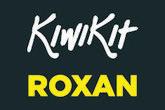
“Sheep are vaccinated for clostridial disease and footrot, although this is something we may phase out as it can hide genetic flaws, which we want to eradicate from the flock.

“We have a good sheep race with

an autoweigh system, so we are hoping to start monitoring weights so we can be more selective in our breeding for the particular traits we need.
Fertilisers


“We do not use any artificial fertilisers or feed concentrates to finish and avoid use of any herbicides. Many of our sites are Sites of Special
Scientific Interest and, as a consequence, are in Environmental Stewardship schemes which further prescribe the things we can and cannot do to the land and the livestock.”
The hill breed lambs are generally finished by the following year, all on grass, and ready for Easter sales, but the Wiltshire Horns will finish on grass by autumn.

Red Poll steers are finished by 24 months and heifers are kept as replacements or sold for breeding.
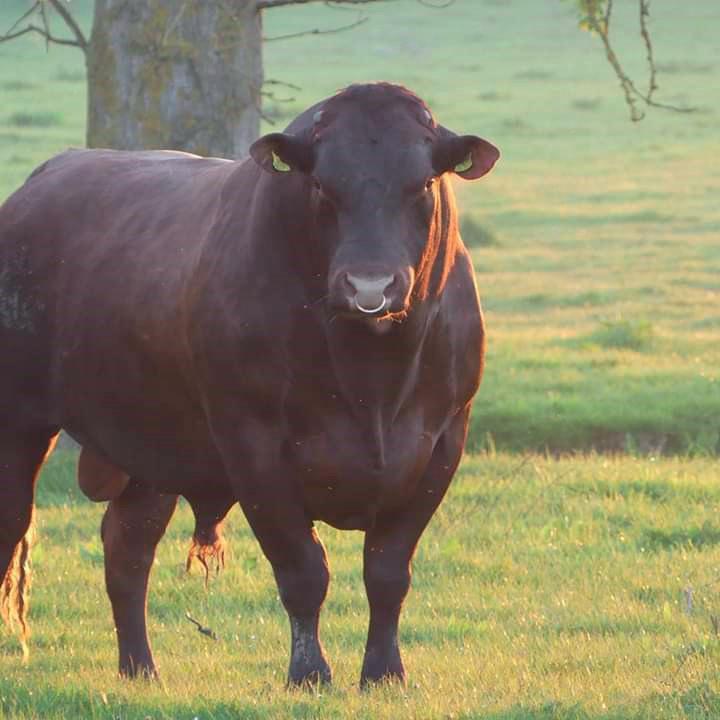
The trust’s current aim is to increase in size both the herd of Red Poll cattle and the sheep flock in order to graze and manage a larger proportion of its sites.
Mr Smith says: “Although the main purpose of the flock is conservation grazing rather than food production, we want to keep breeding ewes so we can maintain a young healthy flock rather than having to constantly buy-in replacements
“This is a more sustainable and biosecure approach, and as a conservation charity should provide better value and more control over issues such as welfare and herd condition, including suitability to site circumstances.”
BREED SOCIETIES Call 01772 799500 and place your ad today FGbuyandsell.com 57 May 26, 2023 | SUSSEX CATTLE SOCIETY 01580 880105 enq@sussexcattlesociety.org.uk www.sussexcattlesociety.org.uk Ideal for grass based extensive management Eligible for SP8 Native Breeds at risk payment currently £167 per ha Killing out in excess of 65% Free Signet Beefbreeder Recording BLACKFACE SHEEP BREEDERS' ASSOCIATION Sale Dates, Sale Reports & News Updates Available to view on our Website and Face book Contact: Aileen McFadzean on 07768 820405 LOOK FORWARD TO SEEING YOU AT NORTH SHEEP The Association is supported by www.scottish-blackface.co.uk
The Trust’s sheep flock consists of Wiltshire Horn (pictured), Black Welsh Mountain and Herdwick crosses.
Brown Swiss add value to Staffordshire dairy herd
Emma Bruce and Rob Darlington, who farm at Chapel Chorlton, Staffordshire, became converts to Brown Swiss 20 years ago because of the breed’s longevity, robustness and high production.
They first encountered the Brown Swiss when Ms Bruce was relief milking and Mr Darlington was working for Andrew Evans at Bubney Farms with a high yeilding Holstein herd.
Ms Bruce was keen to buy a Brown Swiss calf and went to a society sale at Beeston where she bought Kedar
Nofak Ricka, the foundation for their Moonriver herd.

She says: “She was my pick in the catalogue and then at the sale she made a beeline for me in the pen, so had to be my pick of the day.”
Kedar Nofak Ricka went on to be a VG88 cow, calved nine times and gave more than 50 tonnes.
Other purchases soon followed, including three from Alun and Carolyn Davies at Garne, which brought in the Heke and Kuba families; Etvei Jemma from Chris Candy’s sale, who went on to score EX93, and then around eight from Jack Taylor’s dispersal sale,

including members of the Dollmae, Belinda and Fiona families.
Youngstock were kept and reared on Mr Darlington’s parents’ farm near Whitchurch, while those in-milk were housed at Bubney, before the pair took on a private tenancy in Shropshire in 2011.

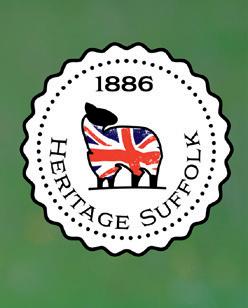




Opportunity

In 2015, with just a few months left on their initial five-year tenancy, they found another opportunity at Churchhouse Farm, Chapel Chorlton, moving there in May 2016.

Cow numbers have continued to

grow, with the milking herd now 220 and the aim of hitting a 240 capacity during 2023.

The couple now have land in Shropshire, Cheshire and Staffordshire extending to 182 hectares (450 acres) including owned and rented land, with youngstock reared at Whitchurch which is a 35-mile round trip.


A calf pad and hutches are the only youngstock space at Churchhouse Farm, before the calves are moved to the youngstock unit.
While Brown Swiss are the breed of choice, accounting for more than three-quarters of the herd either as


| May 26, 2023 58 BREED SOCIETIES FGBuyandSell.com FGbuyandsell.com
Society Sales 2023 028 2563 2342 enquiries@suffolksheep.org Suffolk Sheep Society Ltd Scottish Area Sale (Lanark) 20th & 21st July National Sale (Shrewsbury) 28th & 29th July Northern Ireland Branch Premier Export Sale (Ballymena) 14th & 15th July Northern Counties Branch Sale (Carlisle) 4th August
The Brown Swiss breed has been instrumental in one couple’s journey to run a growing 240-cow, profitable, pedigree dairy herd. Sarah Liddle reports.
pure animals or cross-breds, the remainder are Holstein with one Jersey, in part due to taking on as incoming tenants, the 150 Holstein cows that were on the farm.
The couple both like the first
cross Swiss from the Holsteins and there are several seventh and eight lactation high performing individuals in the herd.

The all-year-round calving herd is total mixed ration (TMR) fed, with no
in parlour or out of parlour feeding and is yielding 9,422kg at 4 per cent fat and 3.45 per cent protein.


Split into two groups, the high yielders are housed all year round, with the low yielders grazing night and day
DARLINGTON
during the summer and the dry cows are housed all year round.
The TMR consists of around 25kg maize, harvested from the 45ha (110 acres) grown, which will now be followed by a cover crop with one eye on minimal cultivation and sustainability, 22kg of grass silage, and around 4kg of home-grown lucerne, as well as blend and home-grown cereals.
Kite Consulting is helping to create the ration to deliver the maintenance plus 30 litres, which is being achieved.

Mr Darlington says: “Looking

FGbuyandsell.com 59 May 26, 2023 | BREED SOCIETIES Call 01772 799500 and place your ad today FGbuyandsell.com
Looking ahead, the belief and will is to push yields higher and over the 10,000kg barrier
ROB
Emma Bruce and Rob Darlington started their Brown Swiss herd 20 years ago.
ahead, the belief and will is to push yields higher and over the 10,000kg barrier through improved grassland management, with the aim being to consistently achieve daily yields of 33kg per cow on twice-a-day milking.”

A multi-cut approach to silaging has been implemented, although the weather in 2022 was not conducive to it, and better grass varieties more suited to multi cuts have been sown.
While ryegrasses have been tried, they were found to be too quick-growing and went to seed too soon, so now the farm has moved to perennial grasses. Westerwold ryegrass will be
grown following the maize to enable an early cut and two cuts in the season.
The use of beef semen on around half the herd and the resulting sought-after calves is an important element of farm cashflow.
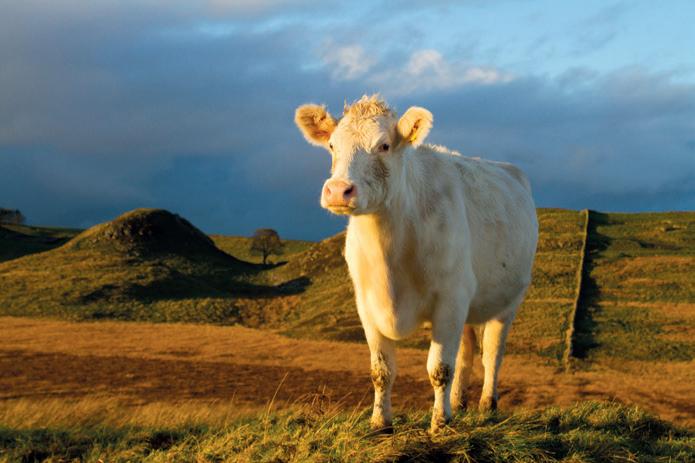
Previously, cross-bred calves were sold through Market Drayton market, but the unpredictability and time and labour constraints have seen a good working relationship develop with Meadow Quality which takes the mainly British Blue cross calves at 2530 days old.
A straw for Brown Swiss cross bulls exchange works well with another
farmer, who takes the steers through from 12 months to around 18-24 months when they go direct to ABP.
The bull calves are castrated and reared at Whitchurch alongside the youngstock.

Structurally, the farm was in sound working order when the couple took on the rolling tenancy, although improvements in cow comfort were soon implemented by replacing the tired cow mattresses with deep filled sand beds, and the more recent addition of a 25-cubicle dry cow shed.

This has not only improved the comfort, but also maintains high udder health and low cell counts.

A more recent investment, partly funded by the technology grant, has been Genus collars, which include rumination and activity.
Ms Bruce says: “I was cynical about them at the onset but have to admit they are working very well, drawing attention to potential oversighted bulling cows and early indication of sick cows and are contributing to the 390 day and falling calving interval.”
From a breeding perspective, the aim is to calve heifers at just over two years, although they have successfully calved heifers in at one year 10 months with no need for a separate heifer group.
Stature

Bull selection is Ms Bruce’s domain. She says: “Latterly, Swiss genetics have tended to tick the boxes of milk, more recently components and avoiding negative fertility sires and, with milk sold to Muller, the high fat production is financially rewarded.”
They feel the herd has enough stature within it already, so no more size in the Moonriver stock is sought and currently calves of Mr Dependable, Martini, Sweet Silver, Seller and Cyrus are growing on well.
If they mature into animals such as Moonriver Cadence Amelia, then they will be happy.
This cow finished top in the society production awards 2022 for both yield and protein. This was after a second
lactation of 12,527kg in 305 days with 432kg fat and 430kg protein, 8,823kg at 4 per cent fat and 3.5 per cent protein in its first. It is now at more than 50kg/day in the third lactation at well under five years of age.
Ms Bruce says: “As pedigree breeders, regardless of breed, it is great to see home-bred cows reaching 100t as we have bred, reared and worked with them every day of their lives.”
Their first home-bred 100t cow will probably be a Holstein, but a first cross Swiss, Moonriver Denpro Anna, which has just completed its eighth lactation is only a few litres off 90t and is carrying a third set of twins.
Lactation
Moonriver Ettal Kylie, a second cross, has just started its eighth lactation with almost 85t of milk under its belt and does not look any older than a fourth calver.
Ms Bruce says: “It makes me chuckle when people say Swiss don’t milk , although I haven’t heard it in a while. We perhaps should be promoting their yields more.
“We did have a pure-bred Swiss who did 80t in eight lactations and had six sets of twins.”

At a recent milk recording, more than 25 per cent of the milkers in the herd were fifth lactation and above, testament to the longevity in the herd.
With the value of the Brown Swiss cull cow approaching £1,500 and cows killing out at 400kg, the couple feel that the whole package of the Brown Swiss and the hybrid crosses of Red Holsteins and even Jerseys, makes for a profitable mix for the farm.

While the production profile sees slightly lower first lactation yields from the breed, they milk on more and for longer, but without lactation peaks to the same level.
In a break with tradition, while the farm has one yard only for loose housing fresh and problem cows, Ms Bruce says the ideal scenario would be to run an old cow group rather than a heifer group to maximise yields and reward the staying power of the breed.
| May 26, 2023 60 BREED
FGBuyandSell.com FGbuyandsell.com Whitebred Shorthorn Association Ltd There will be a good selection of Whitebred Shorthorns For Sale at Scottish Beef Event 9th June 2023 Agri Expo 27th October 2023 Annual Autumn Show & Sale Carlisle 3rd November 2023 www.whitebredshorthorn.com whitebredshorthorn@gmail.com 01434 344716
SOCIETIES
The calves are moved on from the hutches at Churchhouse Farm to Mr Darlington’s parents’ farm near Whitchurch.
Rob Darlington and Emma Bruce.
The cows have deep-filled sand beds for comfort.
First generation farmer Tony Bambridge runs Park Farm on the National Trust’s Blickling Estate near Aylsham in Norfolk.
It is part of a much wider farming business, which trades as B. and C. Farming, established by Mr Bambridge and his former employer, the late David Crown, more than 30 years ago, initially aimed at growing and marketing seed and ware potatoes.
Since then, the business has grown significantly, managing 2,428 hectares (6,000 acres) including contract farming nine other farms.
Cattle have always played a part in the business, as a proportion of the land, both their own and on the contract farms, comprises water meadows which need grazing.
Initially, Mr and Mrs Bambridge had a small suckler herd of mainly Aberdeen-Angus cross and Simmental cross cows before deciding to move to a pedigree breed.
Mr Bambridge says: “Most of the grass is extensive grazing in conservation areas bordering chalk streams which flow into the Norfolk Broads, so we cannot use any fertiliser or chemicals.
“While the continental cross cattle did reasonably well, it is much better suited to a native breed.”
Finished cattle
The finished cattle are all sold to local butcher, Crawford White, of Whites Traditional Butchers in Aylsham, so choosing a breed which met his requirements was also crucial.
Mr Bambridge says: “The beef is hung for 21 days and sometimes 28 days for hotels and restaurants. A carcase with an even fat cover loses less weight than a lean carcase and we have done a trial with a continental cross carcase and a native carcase to demonstrate this.
“Also, he does not want cattle with big back ends. He can sell some ribs and brisket but the most demand is for steak, mince and burgers, so length is more important.
“We are also very much part of his story of provenance and low food miles - selling pasture fed beef from a native breed reared locally on a National Trust farm.
“We do get a premium for the cattle, but it is important not to be too greedy and it always relates back to the published price.

The Bambridges spent two summers visiting agricultural shows looking at various native breeds but kept coming back to the Lincoln Red.
Mr Bambridge says: “In my opinion, the Lincoln Red has been modernised more than any other native breed.
“In the late 1970s and 80s, the society realised the breed was going nowhere so introduced a breed improvement scheme, which has made a big difference and the breed has increased in popularity both commercially and in the showring.
“We also found that the people in the society were really friendly and helpful and were very open in giving their knowledge and time.”
Another benefit of Lincoln Reds is the fact that they are polled and also have a docile temperament.
“We are on a National Trust estate so we have a lot of footpaths, but


Tony Bambridge with his herd of Lincoln Reds.
people do not always stay on those footpaths so having quiet cattle is important,” says Mr Bambridge.
In 2010, as a foundation for their Hobart herd, the Bambridges bought two heifers from the Clough family’s Beverley herd and a bull, Hemingby Dennis, from Michael Read which was also used on the cross-bred cows and those bloodlines are still in the herd today.
First crop
Mr Bambridge says: “We were impressed right from the first crop of calves, both pedigree and commercial. The three-way cross of a Lincoln Red bull onto an Angus cross Simmental cow gave us tremendous hybrid vigour with the calves growing really well.
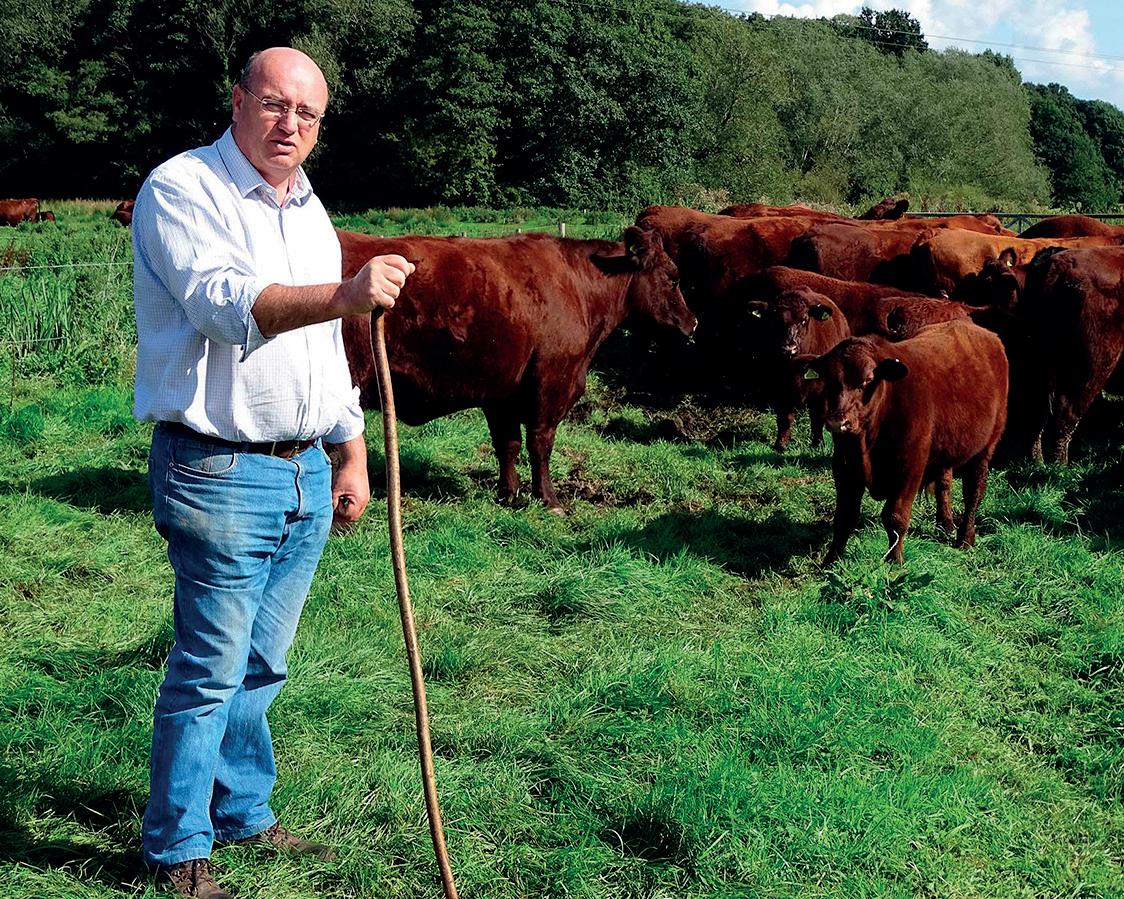

“We then kept buying two or three of the best heifers we could afford at society sales and the herd now comprises of 75 cows, including 18 cross-breds.”
The butcher is able to take 1.5 carcases per week and the Bambridges are currently supplying them 40
FGbuyandsell.com 61 May 26, 2023 | BREED SOCIETIES Call 01772 799500 and place your ad today FGbuyandsell.com Versatile Breed Suitable For All Systems 024 7669 6549 | shorthorn@shorthorn.co.uk | www.shorthorn.co.uk shorthornsiresuk.co.uk SS & SSUK advert 2021 (b).pdf 1 23/05/2023 13:40 Lincoln Reds tick all boxes for National Trust tenanted farm
Finding a breed which suited their end market as well as the farm were key factors for Tony and Emily Bambridge when they chose Lincoln Reds when establishing a pedigree herd. Angela Calvert reports.
BREED SOCIETIES
weeks of the year with the aim of growing that to an all-year-round supply.
The pure-bred cattle generally achieve a daily liveweight gain of 1.15kg, which Mr Bambridge says is adequate. Cattle are slaughtered just seven miles away at Blakes abattoir. Carcase weights range from 300330kg at 15 months old to 400kg at 22-24 months old.
Mr Bambridge says: “We do not want a large carcase. The demographic of most customers is older

or retired and they want a modest 6-9oz steak.
The cattle graze extensively on the water meadows from April until October at a rate of one cow to 1.2ha. Some of the land is designated as Site of Special Scientific Interest and Special Area of Conservation or in stewardship schemes with GS2 and GS6 species rich mixes.
The River Bure runs through the farm and maintaining its water quality is vital, with river banks fenced to keep cat-
tle away. Data shows the river is ‘very clean’, meeting EU water standards and is well populated with brown trout.
Most of the land is sand which can be wet in winter and dry out in summer. Once the cattle come inside, they are fed on seed hay, a by-product of grass which is being grown for seed and stock feed potatoes - another by-product.
The protein ration includes wheat mid-pellets which are the husks of wheat, oilseed rape crush, sugar beet




www.charmoise.org








• Low maintenance
• Easy lambing
• Finish off grass
Farmers using Charmoise say:
Farm facts
■ 75 cows - 18 cross-breds and 57 Lincoln Reds plus followers

■ Mainly spring-calving with a small autumn block
■ The herd is high health and in CHECS and accredited free of BVD, IBR and Johne’s 1 and bTB 4 area
■ Herd is grazing extensively on water meadows during summer

pellets and malt culm pellets, a by-product of malting barley.
Mr Bambridge says: “We are feeding older grass which is high in sugar but with no protein and protein is important to enable the gut to breakdown forage, which is why we need the ration.
“They produce solid butcher’s lambs that come to weight quickly from pasture”
“The lambs are easy birthing, up sucking straight away and as hard as nails.”
“They are suitable to cross with any other breed and will improve conformation of hill breed and will easily produce lambs at 21kg deadweight which will grade E and U.





They have a high meat to bone ratio and will kill out at 52 per cent and because of the fine bone, small head and narrow shoulder they are very easy lambing with a lambing libido not seen in any other sheep.”
David Elgin, Charmoise Hill Sheep Society President and Breeder of Sheep Since 1997


| May 26, 2023 62
FGBuyandSell.com FGbuyandsell.com
HARDY TERMINAL SIRE
CHARMOISE HILL SHEEP THE
Park Farm is on the National Trust’s Blickling Estate near Aylsham in Norfolk.
“Cows are fed 0.25kg/day and youngstock up to 2kg/day at peak.
“We are able to feed a lot of by-products which keeps costs down and use all our straw from the arable operation, which goes back onto the land as muck.

While the herd is not Signet recorded, all calves are weighed at birth, weaning and before they go to the abattoir. Mr Bambridge says one of the biggest differences since moving to Lincoln Reds is the reduction in calving problems.
He says: “Difficult calvings result in lethargic calves which require more time and labour.
“We have only had to assist one or two cows at most and the calves are always up and quick to suckle, whereas we had a lot more problems with the continentals.”
Another beneficial change has been in post-calving management. Heifers, any animal which had twins, needed assistance or had a retained cleansing is seen by a vet to ensure no problems such as metritis develop.
Beef fit for the future
Mr Bambridge says: “This is cost effective and has really paid off. In 2021 we had 100 per cent cows incalf and in 2022, 95 per cent.

Weaning
A progressive weaning system has also been introduced when the herd is housed with calves initially offered a creep gate to a separate area before this is closed, which is proving to be less stressful for them.
The herd is now of a size where
there are a few surplus pedigree Lincoln Red heifers to sell each year along with a small number of bulls and Mr and Mrs Bambridge also enjoy taking a team to Suffolk, Norfolk and Lincolnshire Shows.

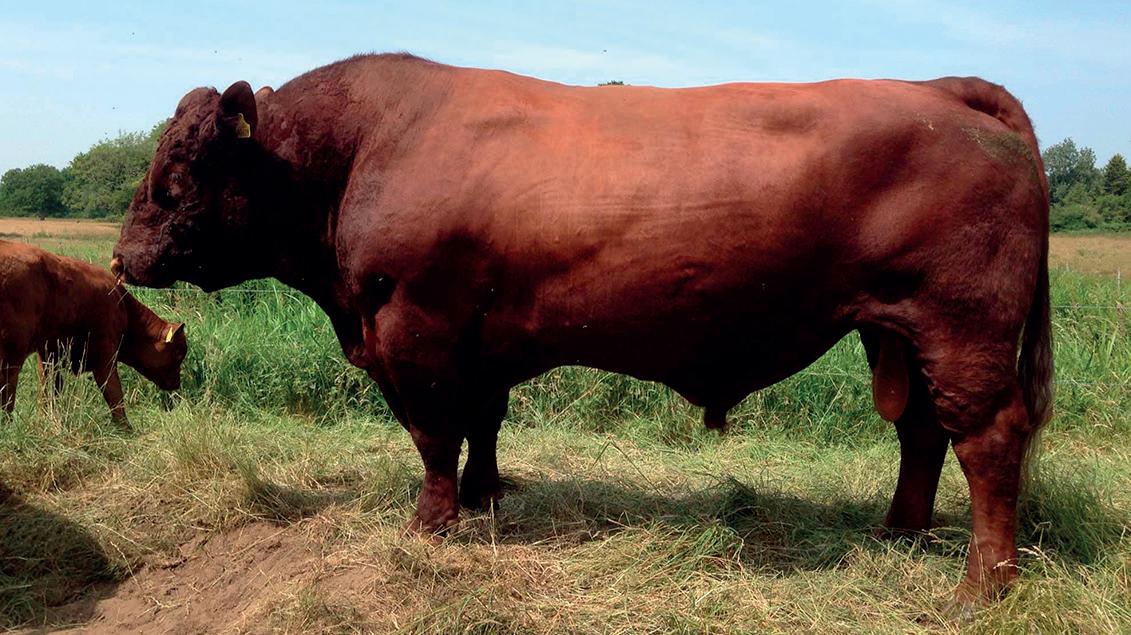
Mr Bambridge’s daughter, Sophie, is now mainly responsible for the day to day running of the arable business, along with manager, Chris Day.
He says: “This has allowed me to step back a bit from the main business and allows me to focus more on the cattle.”

FGbuyandsell.com 63 May 26, 2023 | BREED SOCIETIES Call 01772 799500 and place your ad today FGbuyandsell.com
“We wanted a cow that would look after herself, calf unassisted but also produce high-quality animals for today’s market.”
- Harry and George Gilbert, Harewood Angus, Herefordshire
www.aberdeen-angus.co.uk T: 01738 622477
Mr Bambridge says one of the biggest benefits he has seen since moving to Lincoln Reds is the reduction in calving problems.
Bull Hemingby Dennis was purchased from Michael Read in 2010 and its bloodlines are still in the herd today.
BREED SOCIETIES
North Country Cheviot goes from strength to strength in Northern Ireland
Norman Robinson runs 130 pure-bred North Country Cheviot ewes at his Ballyrolly farm, half of which are kept pure with the other half being put to a Suffolk ram to further his commercial flock.


Pure-bred ewe lambs are sold either to pedigree or commercial flocks or kept as gimmers to expand his own flock. Ram lambs are run on as shearlings, with those not making the grade being finished for slaughter.
Norman, who is the sixth generation to farm the land, works alongside his father Fred, a committed Suffolk breeder who learned many years ago how to optimise the value of a ewe at the end of its working life.
He says: “My father would put a done ewe to a Cheviot ram and sell her with lambs at foot.
“If she produced two females, this
was the difference between selling her for £40 for slaughter or selling her for £200 with the lambs.
“It is a big difference and was a lot of money in those days.”
Despite Fred’s appreciation for the Scottish hill breed, it was not until 1994 that Norman’s own journey
DALESBRED SHEEP BREEDERS’ ASSOCIATION




Secretary: Sarah Fleetwood 07808 781507 sfleetwood10@gmail.com | www.dalesbredsheep.co.uk
with North Country Cheviots began, when he was just 10 years old.
Fred promised his son that if he was successful in his 11 Plus exam, he would buy him five Park-type North Country Cheviot gimmers as a reward.
It was all the incentive the young Norman needed and he promptly passed with flying colours and held his father to his end of the deal.
Fred bought the sheep from the Armstrong family who run the Leam and Stragole flocks and they formed the basis of Norman’s pure-bred
WHEN it comes to commercial breeding programmes, Norman said the real value of the North Country Cheviot is in the body it will bring to a cross, which often leads to an uplift in price in both store and fat markets.
flock today. He says: “When I was growing, all I was used to was Suffolks and their crosses. They are a fantastic breed and we both still have a big passion for them.
“But the Northies were something I could call my own. They were different. Suffolks are all black faced for a start, but Northies are completely white.
“They were just different and when you are young that is important.”
Qualities

Now, after decades of Norman and other top breeders extolling the benefits of the North Country Cheviot, others across the country are starting to appreciate the qualities they can bring to a commercial flock.
This, alongside the reintroduction of the society sale in 2019 after a 20-year absence, has seen membership of the North Country Cheviot Sheep Society in Northern Ireland grow by 150 per cent over the past three years, from 28 members in 2020 to 70 this year.
Prices are also showing an upwards trend, with records being

crosses as top performers. Demand for these commercial ewes is growing, as Norman found out after producing a crop of Cheviot Mules for sale at market.
Annual Show & Sale of Aged and Shearling and Ram Lambs
CCM Skipton - Tuesday 17th October 2023 24th Annual Show & Sale of Rams, followed by Dalesbred Gimmer Lambs & Ewes
He added females can be crossed with almost any other breed to produce a good commercial ewe, citing Bluefaced Leicester, Border Leicester, Texel, Suffolk, and Beltex
He says: “I did not make it to the sale. I put them on Facebook and had sold all of them within 25 minutes. I could have sold them six times over. The sky is the limit for selling crossbred females from a Cheviot ewe.”
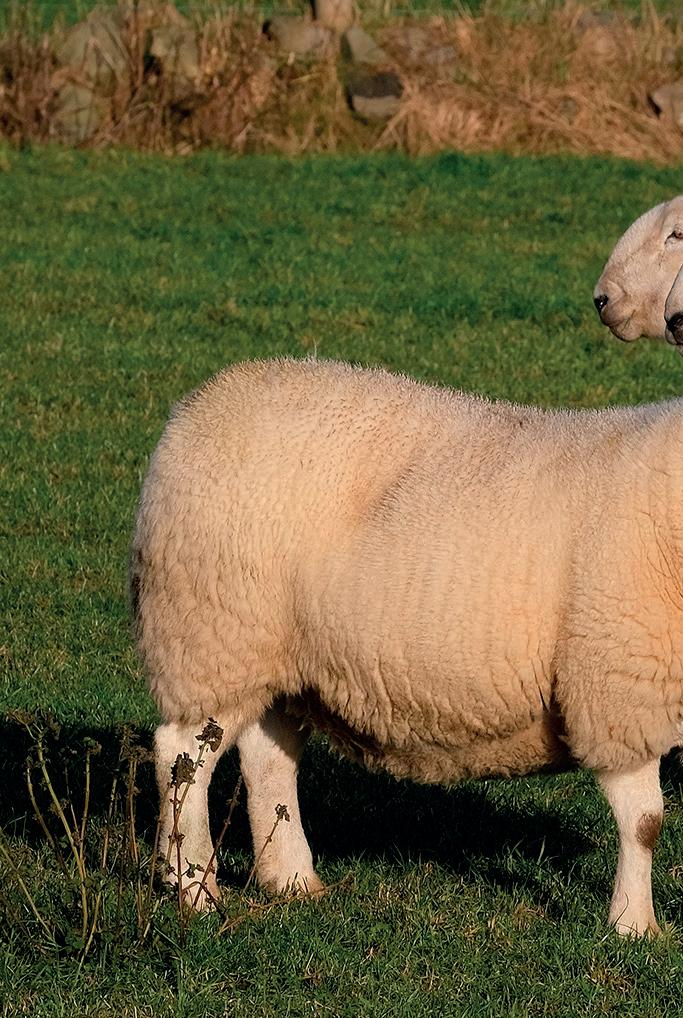
FGBuyandSell.com FGbuyandsell.com | May 26, 2023 64
A new North Country Cheviot Sheep Society sale and the growing appreciation of the breed’s commercial qualities is fuelling a surge in its popularity in Northern Ireland.
SALE DATES 2023 Bentham Auction MartFriday 6th October 2023 92nd Annual Show & Sale of Draft Ewes Bentham Auction Mart -
92nd
Monday 9th October 2023
PICTURES: COLUMBA O’HARE
Norman Robinson and his father Fred on their farm near Downpatrick.
North Country Cheviot in-lamb gimmers.
North Country Cheviot Mules
broken each year. At last year’s society sale at Beatties Livestock Centre, Omagh, in September, a shearling ram from Norman and Fred’s Benrafton flock sold for 2,600gns, beating the previous record of 1,800gns, and the top selling gimmer ewe changed hands at 3,000gns, obliterating the previous record of just 840gns.
Norman also sold a gimmer ewe
MUCH of the stock seen in Northern Ireland is being brought in from the North Country Cheviots’ Scottish heartlands as breeders head across the Irish sea to sales in Lockerbie, Dingwall, Lairg, and Caithness.
Irish-bred North Country Cheviots are finding success at some of the major shows, with a two-shear ewe from Norman’s Benrafton flock taking breed champion and reserve interbreed champion Longwool interbreed, at last year’s Balmoral Show.
Going one better at this year’s Balmoral Show earlier this month, a two-shear ewe from Jack Smyth and William Rankin, Newtownstewart,
privately for 2,500gns. He says: “There is a big demand for the females at the moment.
“It is because they give so much back. They take little feeding and they do not need flushing like other breeds do. They produce plenty of milk and can be crossed with anything to produce something that can be sold in commercial markets.
“They are also long-lived. You
which had been bought as a hogg from the Allanshaws flock, Galashiels, claimed the longwool championship and overall inter-breed title.
Norman says: “A lot of the boys are going over to Lockerbie and spending good money and it is beginning to show. If you get a good Northie at a show, it is a hard job to stop it at a longwool inter-breed.
“A good one will win eight times out of 10. But it is not just about the quality of the sheep.
“There is a fantastic social scene with the shows and the people are great. That is why it gets under your skin. I love everything about it.”
NEW SOCIETY PRESIDENT
THE North Country Cheviot Sheep Society will continue to promote the breed strongly in Northern Ireland, as well as across the mainland UK, under the experienced eye of new president, Robert MacDonald.

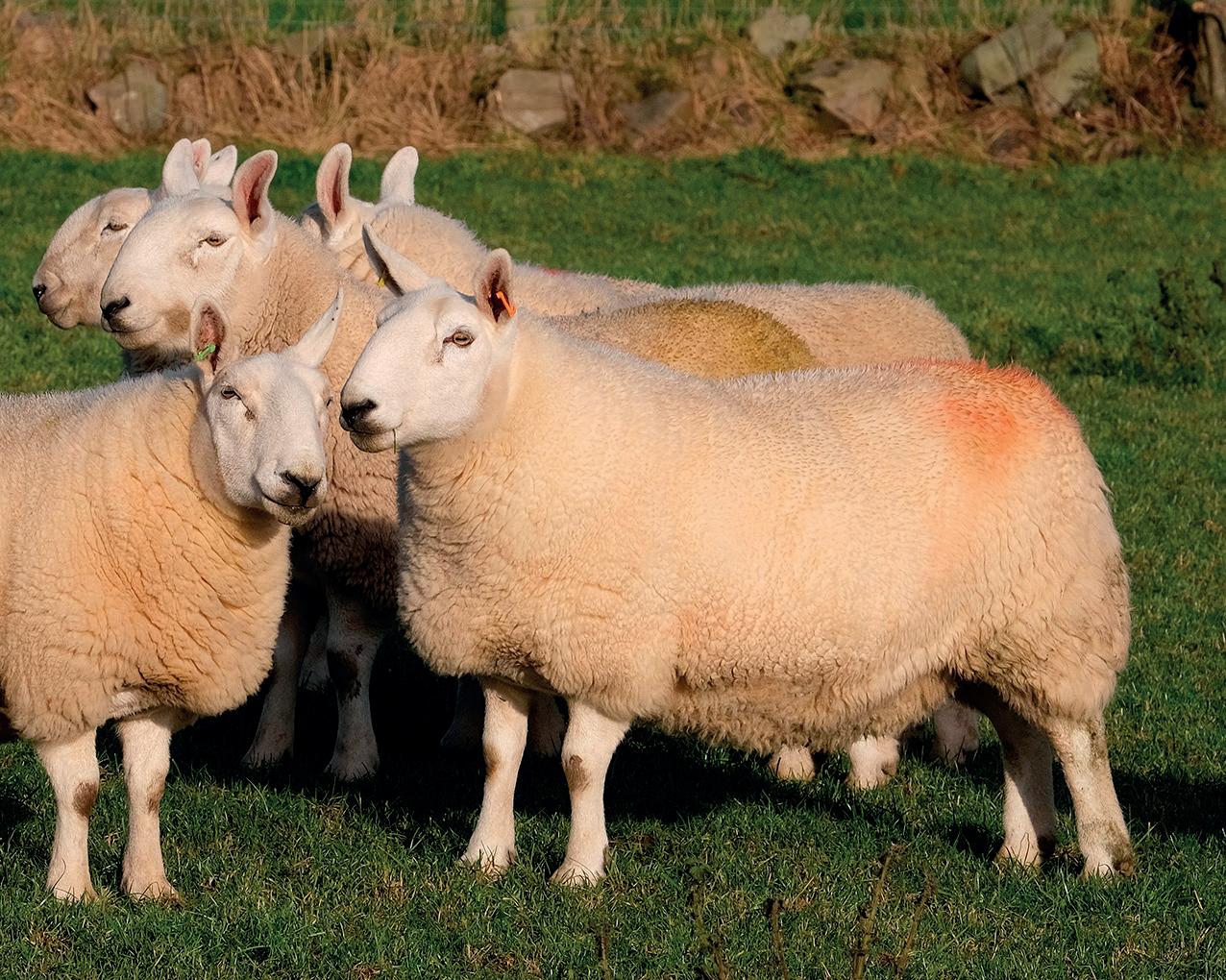

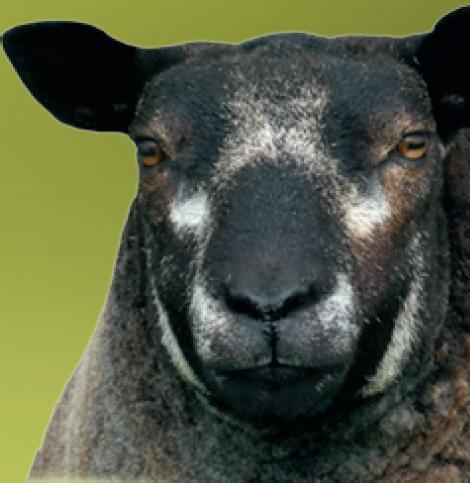
He runs 570 Hill-type North Country Cheviot ewes at Castle Grant Home Farm, near Grantownon-Spey, Moray.

He took over the presidency from Welsh breeder, Melfyn Williams at the society’s AGM in November last year and will complete a two-year stint in the role.
He says a key factor in the success of the breed in Northern Ireland is the reintroduction of the society sale, which provided a platform on which
have no bother getting five or six crops of lambs out of a ewe.
“The renewed club sale has been a big factor in turning commercial breeders’ heads towards the Northie. For a long time, we did not have a sale in Northern Ireland so I think people forgot them. Other breeds had sales and their popularity
to showcase the refinements the breed had gone through over the past 20 or so years.
Mr MacDonald says: “Northies are high health animals with tight skins, good coats, and good feet that have been bred to thrive in the far north. Because of this, they are very well suited to the climate and geography of Northern Ireland.
“It is wonderful to see a growing recognition of this across the Irish Sea and for that to turn into new members of the society. With the work of experienced breeders like Norman and newcomers being attracted to the breed, I feel the Northie has a bright future as a true all-rounder with something to offer everyone.”
continued, so it definitely makes a difference.
“If people see a sale is happening, they are attracted to it. They will go along and have a look at the stock being sold and if they see quality, they might be tempted to try something different. We are seeing that now with Northies.”

BREED SOCIETIES Call 01772 799500 and place your ad today FGbuyandsell.com 65 May 26, 2023 |
Sale Dates 2020 SECRETARY CHERALYN HENDERSON Cragg House Farm, Out Lane, Chipping, Pres on, Lancashire PR3 2NQ E hello@blue-texel-sheep.com T: 01995 61368 M: 07887 742915 B LUE T EXE L SHEE P SO CI ET Y Over 90% Commercial Lambs Born White Easy Lambing Exceptional Carcase Quality Excellent Growth Just From Grass Superb Maternal Ability Longevity Hardiness Easy Care Both Maternal & Terminal Sire Producers The Terminal Sire Which Ticks ALL The Boxes www.blue-texel-sheep.com NEW VENUE 19th August (Wednesday) NSA South West Ram Sale Auctioneers: Kivells, Exeter Livestock Centre, EX2 8FD 28th August (Friday) Northern Supreme Blue Texel Sale Auctioneers: H & H, Borderway Mart, Carlisle CA1 2RS 31st August (Monday) The Northern Ireland ‘Premier’ Blue Texel (Export) Sale Auctioneers: Dungannon Farmers Market, Dungannon BT70 1NJ 4th September (Friday) Southern Supreme Blue Texel Sale MV & Non MV Auctioneers: Mccartneys, Worcester WR4 0SQ 12th September (Saturday) Melton Mowbray Blue Texel Sale Auctioneers: Melton Mowbray Market, Melton Mowbray LE13 1JY 12th September (Saturday) St Asaph Blue Texel Sale Auctioneers: Jones Peckover, St Asaph Livestock Market, LL17 0LT 25th September (Friday) Frome Blue Texel Sale Auctioneers: Frome Livestock Market, Somerset BA11 2QB 26th September (Saturday) Carlisle ‘Blue Blinders’ Blue Texel Sale Auctioneers: H & H, Borderway Mart, Carlisle CA1 2RS NEW VENUE The Terminal Sire Which Ticks ALL The Boxes Over 90% Commercial Lambs Born White Easy Lambing Exceptional Carcase Quality Excellent Growth Just From Grass Superb Maternal Ability Longevity Hardiness Easy Care Both Maternal & Terminal Sire Producers Office & Registrations – Pedigree Livestock Services E: office@bluetexelsheep.co.uk T: 01768 870523 www.blue-texel-sheep.com
A pen of in-lamb females on the Robinsons’ farm.
Scottish heartlands
BREED SOCIETIES
In a large breed society of 2,300 members, having well-managed regional clubs is essential to providing ‘ground up’ member involvement, believes Texel Sheep Society chief executive John Yates. He says: “There is no doubt the Texel membership’s 19 regional clubs and breeders’ groups are an important complement to the society. While they operate independently, they provide valuable local events and activities according to society members’ requirements.
“All the regional clubs are run by members for members, with their own committee structure and governance, allowing them to tailor activities to regional needs.”
Texel regional clubs are also supported by the society, receiving promotional materials and an annual grant towards their activities, with encouragement to invest this in youth initiatives.
Mr Yates says: “Historically, clubs managed their own sale entries and cataloguing. However, since the introduction of the society’s online database, iTexel.uk, most clubs now use the society for entries and cataloguing.
“This has taken a lot of mundane work away from club secretaries, reduced paperwork and improved timeliness.”

Alongside its regional clubs, the society is also highly supportive of its younger members. Mr Yates says: “When you support young members and make them a core part of an organisation, they stay with the organisation longer and become valuable, active members. It is the same with attracting and investing in young staff to retain and grow the organisation.”
Young breeders have always been active within the Texel Society, and the launch of the society’s Youth Development Programme (YDP) in 2012, with the support of then society chair, Nick Tavernor, provided the impetus to co-ordinate these activities under one banner.
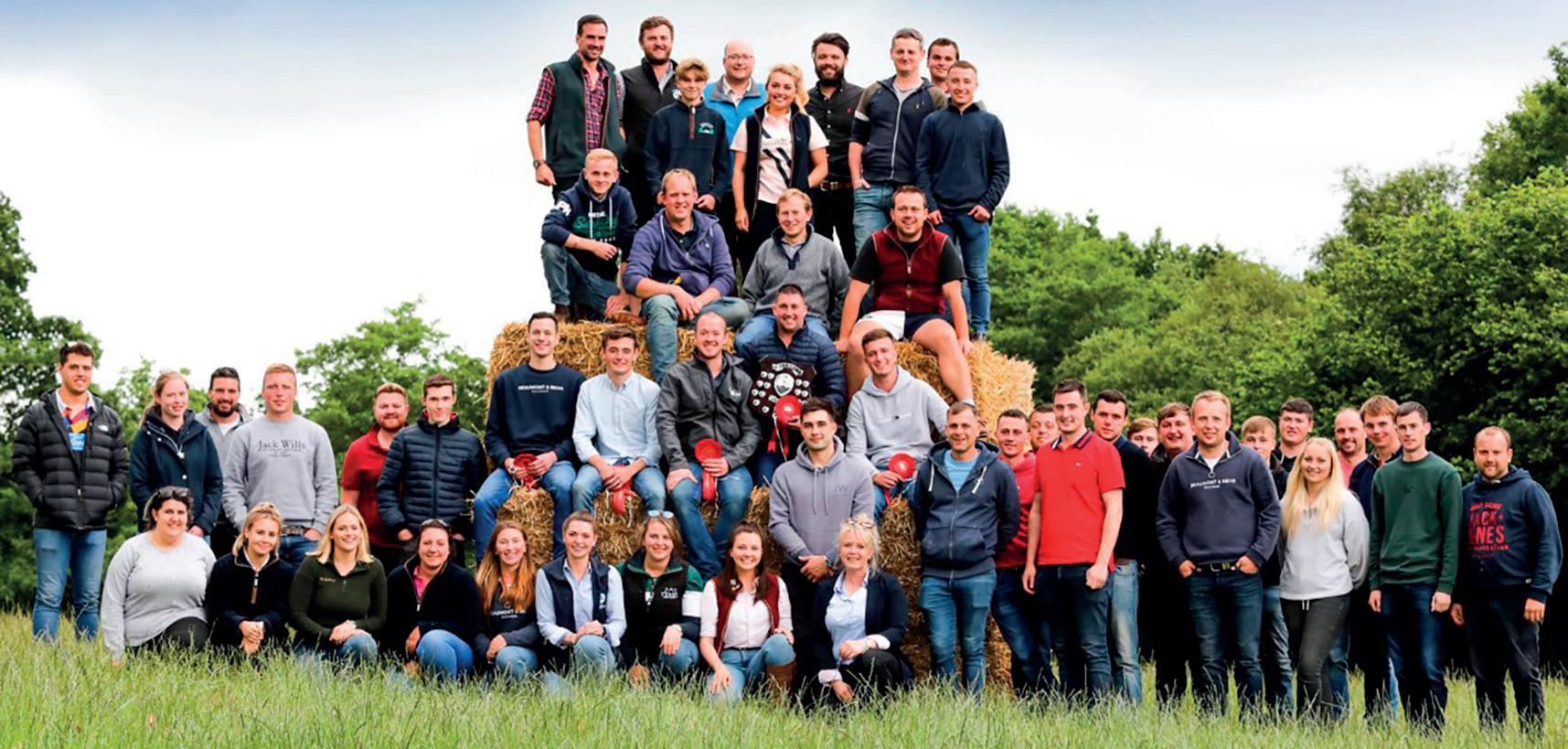
Mr Yates says: “Like any new initiative, it took time to build in the early
Texel success supported by youth and regional clubs
years, but with the continued backing of the society leadership and the determination of young breeders, it is now in its 11th year and has become a core part of society activities.”
Education
The YDP also operates a university awards scheme, offering educational awards at a college or university in each of the home nations for the student completing the best sheepbased dissertation or project.
“Inspiring keen, passionate young people to become involved in the
sheep industry while studying hopefully gives them the desire to remain in the sector after their studies, in the huge range of careers that sheep farming and its ancillary industries offer,” says Mr Yates.
Most recently, pulling together both the regional club activities and the society’s YDP, the society launched a Spotlight Award. Mr Yates says: “There are always unsung heroes who go about their business and can be overlooked because they do not seek the limelight, they just get on with doing what needs to be done.
“So, to help give these people some recognition, the Spotlight Award was introduced. Entrants have to be under 35 years of age and be nominated by their regional club, along with a testimonial explaining why it feels they deserve recognition.
Competition
“The winner this year was Thomas Illingworth of the Solway and Tyne Club, but there was stiff competition among all of the entrants, and I am looking forward to seeing this award develop in future years.”
Southdown Sheep Society launches Young Breeders Group
THE Southdown Sheep Society has introduced a new initiative aimed at supporting and encouraging its younger members.
Initiated by young breeders Emily Yates and Tom Chester of the Fulfen and Chapel House flocks, respectively, the new Young Breeders Group kicked off this year with the introduction of young breeders’ championships at the national show, as well as its official sales at Worcester and Melton Mowbray. Society chair Jonathan Long says: “It is important that young
breeders are supported, and the society is keen to see the group expand its footprint within the breed and the society over the coming years.
“However, it is also important that young breeders themselves are at the forefront of developing the group, so they can tailor the group’s activities to suit their needs.”
Emily Yates says the foundation for the group came from conversations between younger members over recent years. She says: “We felt it important that younger breeders had a
forum in which they could interact with each other while also learning from each other and more experienced breeders. Combining practical and social elements to events will hopefully appeal to many young breeders.”
In time, the aim is to develop a series of workshops and events specifically tailored to younger breeders. “Introducing these new championship awards is a great first step, and now we want to hear from young breeders about what they want to see happen, so we can take
the next steps,” says Mr Chester.
Mr Long adds: “Retaining younger members is vitally important for any society, and providing a pathway for these young people to become more involved through the Young Breeders Group will hopefully encourage them to remain with the breed as they move through life.”
Young breeders wanting to learn more about the Southdown Youth Group should in the first instance email the Southdown Sheep Society office on secretary@ southdownsheepsociety.co.uk’
FGBuyandSell.com FGbuyandsell.com | May 26, 2023 farmersguardian.com 66
Catering for all members, whatever their age or location is key to the success of breed societies. Farmers Guardian reports.
Young Texel breeders at the YDP Five Nations Weekend held in the Welsh Borders.
Please feel free to contact
Richard – 07816 173689

John – 07885 739120
Gilmartin
Pedigree Polled Hereford Bulls
3 Well bred, Halter trained Bulls 18 months - 2 years.
Choice of 20 from our 180 cow herd
TB4 BVD & Lepto vacc. Call Henry 07866 222062 - details on website www.ribbleaberdeen-angus.co.uk
Performance recorded,
Fertility
PEDIGREE LIMOUSIN BULLS
NO DE-HORNING REQUIRED ALL CALVES WILL BE BORN WITHOUT HORNS
THE TREDON HERD - (Limousins)
HOMOZYGOUS POLLED CHOICE OF 6 RED OR BLACK
Vaccinated for BVD + IBR, TB 4 Area Tel: 01461 600257
• Good conformation & muscling • Exceptional temperament.
• High health status. TB4. • Ready For Work • Semen tested Prices start from £3,000 Also available a selection of cows and heifers for sale. Tel: 07849 153733 or 01223 426412
Aberdeen Angus Bulls For Sale

Genuine, Quiet Bulls, Ready to Work 14-16 months old.

Viewing welcome anytime Telephone: 0771 8984010 carthorpefarm@gmail.com
Bedale, North Yorkshire
FRESH REARING CALVES
Available in suitable batches delivered to most parts of the country
Continental Bull and Heifer calves
3-5 weeks old available now. Quality store cattle sourced directly from Welsh/Shropshire Borders Farms, delivered to your farm. Delivery Nationwide.
Livestock Supplies Ltd


Ashley: 07831 887531 Office: 01829 260328
www.livestocksupplies.co.uk

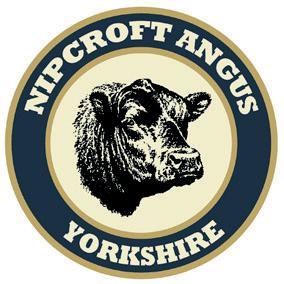

Five Red and Black Limousin stock bulls

17-22 months. Some Semen tested. TB4 area.
Younger bulls also available
Abberton Angus Bulls
| June 29, 2018 60 p060.indd 60






and Heifers
accreditation IBR, BVD, Lepto Johnes
Tel: 01386 462534 or 07592 798555 abbertonaberdeenangus.co.uk

Bulls and select Females for Sale from a high health herd, with fully registered
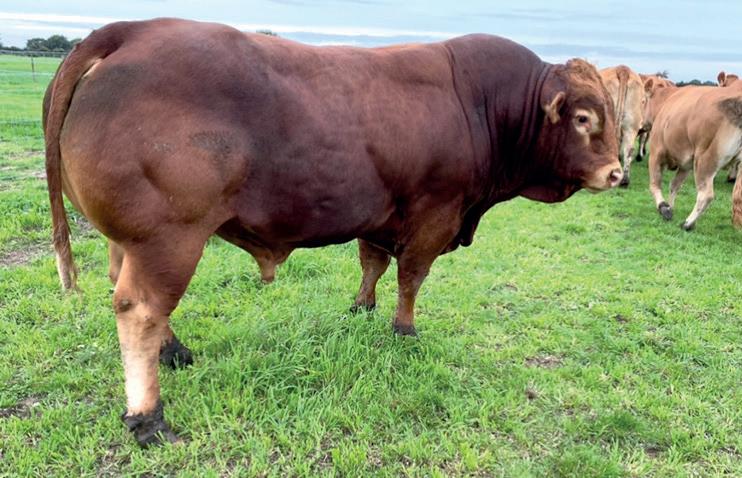

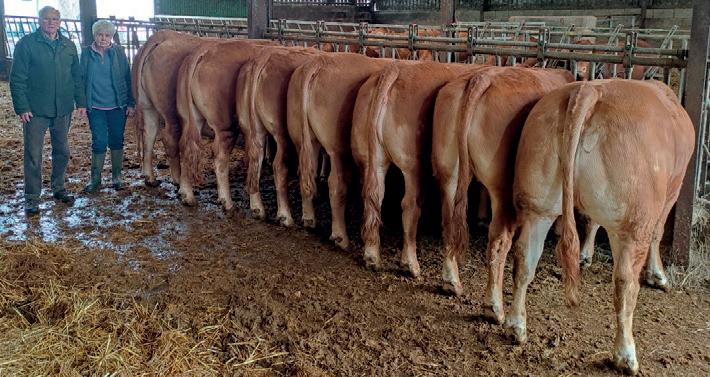
www.lowergroveherefords.com
Contact: Paul on 07730095062 or paul@lowergroveherefords.com
3 yrs old, TB tested, Farm Assured. Telephone: 07776 192162 Oxford (P)
FOR SALE FROM LEESEMANOR BEEF
PED AA BULLS for sale. Hi Health. TB4. Suit commercial & ped breeders. Oakmoor Angus, Tel: 07563 339979 York (P)
Bulls X 2. 2 years old from long established herd. DNA tested myostatin 0 and 1. Other classes of breeding stock also available. Tel: 01952 222134 or 07811 593260
PEDIGREE
Quality, home-bred Limousin cross British Blue young cows and heifers, with Lim x and BB x calves at foot. Also two excellent Lim x British Blue bulls. Eager for work, all quiet, TB tested and ready to go.
PEDIGREE LIMOUSIN bulls16 months old. well grown shape and style. quite temperment good length 0779047517 (T)
Shropshire (P)
AA ABBERTON ANGUS bulls & heifers,TB1, biobest elite health 10 years accreditation IBR, BVD, Lepto Johnes - Tel: 01386 462534 or 07592 798555 abbertonaberdeenangus.co.uk



TOP PEDIGREE REGISTERED HEREFORD BULLS AND HEIFERS. All home bred, quiet to handle. Delivery available. 07885 594143 or 01394 460408 (East Anglia)

Beef Cattle
FGbuyandsell.com
Call 01772 799500 and place your ad today
DEVON
SOUTH
www.auctionfinder.co.uk Your one stop shop for all agricultural sales FG ROUGHLEY LIMOUSIN Dispersal sale of Pedigree Limousin Cattle by Private Treaty • Premium Cattle Health Scheme • Johnes Risk Level 1 • BVD Free CALL NOW ON: 07717 703037 PEDIGREE ABERDEEN ANGUS & HEREFORD BULLS Bulls for sale Individually Health Tested TB Tested Ready to work Delivery can be arranged Tel: 01538 300331 or 07968 622950 Staffordshire (P) PEDIGREE SIMMENTAL BULLS Easy Calving,
vaccinated. Ready for work, Herd never had TB Tel: 01948 770408 Mob: 07714 089001 Malpas, Cheshire 2 Pedigree Aberdeen Angus Bulls
Good temperament. Johnes & BVD accredited, lepto
At Your Service Quality Breeding, Hi Health 07891 781542 airedaleangus@outlook.com Pedigree
UK and America.
PEDIGREE Homo
Tel:
Tel Edward: 07770 457453 N. Yorkshire (P) North
NEEDHAMS COCKERINGTON HERD Phone: 07778 464091 or 01507 327549 Easy calving and excellent temperament, High health, TB4, Semen tested, Delivery can be arranged Phone now for special prices
ALWAYS NEGATIVE FOR TB Wilf Lomas - 01606 832142 or 07769704628
Last 5 Bulls available
Nationwide delivery
District,
Pilsbury Aberdeen Angus Available from May 2023
Functional, fertile, forage fed young bulls from our 120 cow herd reared at 1000ft suitable for pedigree, dairy and suckler heifers.
tested. Johnes, BVD, IBR accredited
07966 360210 Peak
Derbyshire
TB1, biobest elite health 10 years


















































































































































